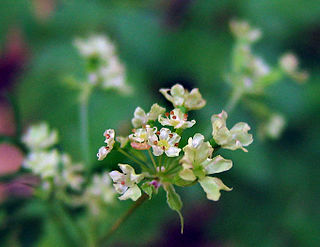The Prodoxidae are a family of moths, generally small in size and nondescript in appearance. They include species of moderate pest status, such as the currant shoot borer, and others of considerable ecological and evolutionary interest, such as various species of "yucca moths".

Acleris semipurpurana is a species in the moth family Tortricidae, and one of several species of moth commonly known as oak leaftier or oak leaf tier. The larvae feed on the leaves of oak trees in the Eastern United States and southeastern Canada which can be a major cause of defoliation. The loss of leaves can kill or damage the affected trees, which are chiefly in the Lobatae or red oak section of Quercus, or oaks.

Osmorhiza brachypoda is a species of flowering plant in the family Apiaceae known by the common name California sweetcicely.

Meganola strigula, the small black arches, is a moth of the family Nolidae. The species was first described by Michael Denis and Ignaz Schiffermüller in 1775. It is found in Europe, Russia and Asia Minor.
Greya is a genus of moths of the family Prodoxidae.
Greya variata is a moth of the family Prodoxidae. It is found in herb-rich meadows and along forest edges in the central Rocky Mountains at the border between the United States and Canada.
Greya variabilis is a moth of the family Prodoxidae. It is found on the Yugorski, Taymyr and Chukchi peninsulas of arctic Russia, the Pribilof Islands, Alaska and along the North American west coast. In the northern part of the range, the habitat consists of tundra. In the south, it occurs in moist coniferous forests.
Greya pectinifera is a moth of the family Prodoxidae. It is found in moist coniferous forests on the Olympic Peninsula and in the Mount Rainier region of the Cascades in Washington.
Greya politella is a moth of the family Prodoxidae. It is found from southern British Columbia to the Channel Islands of California and the southern Sierra Nevada, and from the Pacific coast to eastern Idaho and south-western Colorado. It is found in a variety of habitats, ranging from open oak woodlands in the south to open grassland and the edges of dry, open ponderosa pine forests in the north, as well as sagebrush steppe in Washington.
Greya enchrysa is a moth of the family Prodoxidae. It is found in open, grassy pine forests in the drier interior regions of southern British Columbia, Alberta, Washington, Oregon, Idaho and western Montana.
Greya piperella is a moth of the family Prodoxidae. In North America it is found from southern British Columbia to central Oregon, west to western Montana. There is an isolated population in central California and the species is possibly also present in New Mexico and Utah. The habitat consists of open, grassy pine forests or rockfaces in open country.
Greya mitellae is a moth of the family Prodoxidae. It is found in moist coniferous or mixed coniferous forests in north-western Idaho and the Blue Mountains of south-eastern Washington.
Greya punctiferella is a moth of the family Prodoxidae. It is found in the Pacific coastal ranges, the western slopes of the Cascades and in parts of the Sierra Nevada from south-eastern Alaska in the north to the Mendocino region of northern California in the south. The habitat consists of moist, coniferous or mixed conifer-Alnus forests.
Greya obscura is a moth of the family Prodoxidae. It is found from south-western Oregon to the San Garbriel Mountains and the southern Sierra Nevada of California. The habitat consists of grassy portions of open oak woodland.
Greya powelli is a moth of the family Prodoxidae. It is found in the coastal range between the San Francisco Bay area and the San Gabriel Mountains, and in the south-central Sierra Nevada of California. The habitat consists of slightly moist grassy areas in open oak woodland.
Greya solenobiella is a moth of the family Prodoxidae. In the United States it is found from south-western Oregon south to California, where it is found along the coast and in the Sierra Nevada. The habitat consists of grassy areas in dry to moderately moist oak or mixed deciduous forests.
Greya reticulata is a moth of the family Prodoxidae. It is found from the coastal range of California in the United States.
Greya subalba is a moth of the family Prodoxidae. In North America it is found in southern British Columbia, Alberta, Washington, Oregon, northern Idaho, western Montana and south to south-western Oregon. The habitat consists of dry, forb-rich steppe.

Chionodes continuella is a moth of the family Gelechiidae. It is found from most of Europe, east to Japan. It is also present in most of North America.

Phloiophilus edwardsii is the sole known species of the beetle family Phloiophilidae in the superfamily Cleroidea. It is native to Europe. The larvae are mycophagous, and have been observed feeding on basidiomycetes of the genus Phlebia growing on dead oak branches. The larvae are active during the winter period, before entering the soil to pupate in late spring-early summer.




